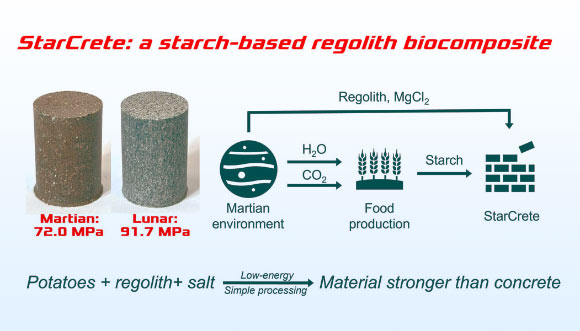The StarCrete is twice as strong as regular concrete and is made from extraterrestrial dust, potato starch, and a pinch of salt.
Aled Roberts and Nigel Scrutton used simulated Martian soil mixed with potato starch and a pinch of salt to create the material that is twice as strong as ordinary concrete and is perfectly suited for construction work in extraterrestrial environments. Image credit: Aled Roberts & Nigel Scrutton, doi: 10.1515/eng-2022-0390.
A sustained human presence on the lunar and Martian surfaces will require habitats with thick walls and ceilings for protection against radiation exposure and meteor strikes.
Due to the high cost of transporting mass from Earth to space, bulk construction materials will be produced from locally available resources — a concept known as in situ resource utilization.
The stabilization of loose, unconsolidated regolith (i.e., dust and soil) into a solid concrete-like material would not only provide radiation- and micrometeoroid-shielding, but could also allow the deployment of relatively lightweight, inflatable habitats by countering the extreme thermal and pressure differences between indoor and outdoor environments.
Although there have been several proposed solutions to the stabilization of regolith for extraterrestrial construction, most have major drawbacks such as extremely high energy or water use, or the need for additional high-mass mining, transportation, processing or fabrication equipment which would add to the cost and complexity of any mission.
One potential solution is the use of naturally occurring biopolymers as regolith binding agents to produce extraterrestrial regolith biocomposites.
Starch is an abundant plant-based carbohydrate and is the main source of calories in the human diet.
In addition to food, starch is also employed industrially as an adhesive/binder for various applications — including paper, cardboard, and textile manufacture.
Starch has been extensively investigated as a binder for plant fiber-based biocomposite materials; however, relatively poor mechanical properties and moisture sensitivity limit their applicability.
In the new research, University of Manchester scientists Aled Roberts and Nigel Scrutton demonstrated that starch can act as a binder when mixed with simulated Mars dust to produce a concrete-like material.
When tested, StarCrete had a compressive strength of 72 Megapascals (MPa), which is over twice as strong as the 32 MPa seen in ordinary concrete.
StarCrete made from the lunar dust was even stronger at over 91 MPa.
“Current building technologies still need many years of development and require considerable energy and additional heavy processing equipment which all adds cost and complexity to a mission,” Dr. Roberts said.
“StarCrete doesn’t need any of this and so it simplifies the mission and makes it cheaper and more feasible.”
“And anyway, astronauts probably don’t want to be living in houses made from scabs and urine!”
The researchers calculated that a sack (25 Kg) of dehydrated potatoes (crisps) contain enough starch to produce almost half a ton of StarCrete, which is equivalent to over 213 brick’s worth of material. For comparison, a 3-bedroom house takes roughly 7,500 bricks to build.
Additionally, they discovered that a common salt, magnesium chloride, obtainable from the Martian surface or from the tears of astronauts, significantly improved the strength of StarCrete.
The next stages of this project are to translate StarCrete from the lab to application.
“It is worth noting that since cement and concrete account for about 8% of global carbon dioxide emissions, further development of StarCrete could result in a relatively sustainable alternative for Earth-based construction,” the scientists said.
“For this to be achieved, the moisture-sensitivity of starch binder needs to be overcome.”
“This could be achieved through the incorporation of covalent crosslinking agents, heat-induced crosslinking, or other biopolymer additives such as proteins, waxes, or terpene-based resins.”
Their work was published in the journal Open Engineering.
_____
Aled D. Roberts & Nigel S. Scrutton. 2023. StarCrete: A starch-based biocomposite for off-world construction. Open Engineering 13 (1); doi: 10.1515/eng-2022-0390




